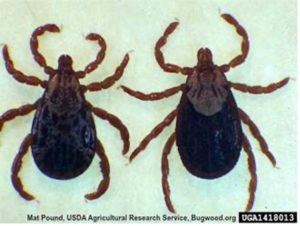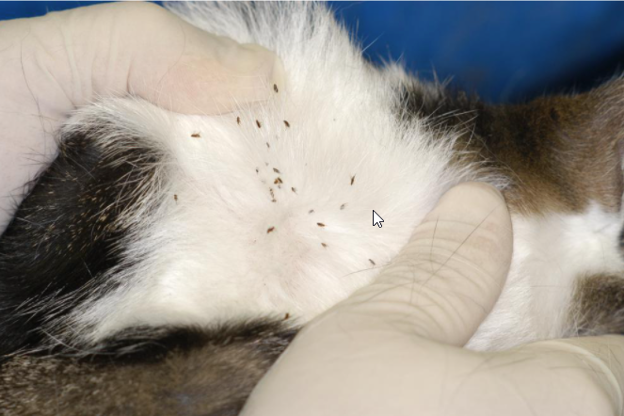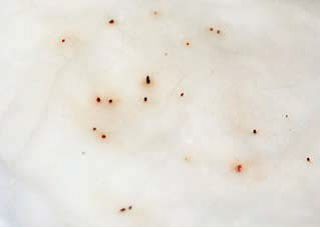Pest season is here. While pests can plague us throughout the year, May, June, and July are the peak seasons pests in Nevada. Pest prevention is the best remedy. But before we go into that, it helps to know how to detect them and get rid of them.
Pest Prevention Begins with Recognizing the Problem
Ticks and fleas are both nasty bugs that can live in your pet’s fur and then bite them to feed off of their blood. One of the scariest things about them is that they can each potentially transmit disease to your pet.
As if this wasn’t bad enough, it’s also possible for you to become infected by something from them. Although this is a rare occurrence, you can check out more information on that here if you’re interested.
To be successful at pest prevention, you need to know what the different pests look like and how to recognize when your pet has an infestation.
Recognizing a Tick Problem:
There are many varieties of ticks. The most common one in Nevada is the Rocky Mountain Wood Tick.

The Rocky Mountain wood tick can transmit Rocky Mountain spotted fever, Colorado tick fever, as well as cause tick paralysis. For more detailed information about the Rocky Mountain wood tick visit PestWorld.org.
Symptoms of a possible infestation:
- Licking or chewing: Your pet may lick or chew at the spot on their body where the tick is attached.
- Inflamed skin: The skin around where the tick is attached will become red and inflamed.
- Anemia (not enough red blood cells): If there are several ticks on your pet’s body, they can drink so much of their blood that your pet becomes anemic and gets pale gums. They will also be lethargic.
- Lyme disease: Dogs can contract Lyme disease from ticks. Lyme disease can cause their joints to swell, lack of appetite, fever, and reduced energy. Lyme disease is not common in Nevada but it is good to be aware of it, especially if you are going to travel with your dog.
Recognizing a Flea Problem

Photo Courtesy of Dr. Michael W. Dryden
Some people think that a few fleas on their pet will not harm them. However, this is not the case. A pet can suffer from an allergic reaction from just one single flea bite. Additionally, fleas reproduce quickly and abundantly. A female lays up to 50 eggs per day!
Here are some signs that can help you spot a flea problem:
- Excessive scratching or biting at their skin: Your pet will scratch and bite at the spot where the flea bites them. Not only can their bite be painful, but they also excrete a substance that causes irritation and itching.
- Flea “dirt”: If you notice tiny black or dark specks on your pet’s fur, this is usually flea excrement. How can you tell the difference between dirt and flea dirt? Put some of the dirt on a wet paper towel. If it is flea waste, it will turn a dark reddish-brown color from the digested blood.

Picture of flea dirt on a wet paper towel by Merck Animal Health
- Hair loss: Some pets react to flea bites by losing fur around where fleas have bitten them. Your pet may also pull out their fur by continually scratching or biting at the bite spots.
How Do You Deal with Ticks or Fleas?
Now that you’ve identified the problem, here’s what you can do to handle it:
Ticks
Make an appointment for professional help; this is the easiest and safest step to take to ensure your pet gets the best care possible. If you want to try and handle the problem yourself, this is how you can remove a tick safely.
First, you need some supplies:
- Gloves
- Clean tweezers
- Disinfectant or antiseptic cream
- Isopropyl alcohol
Once you have these supplies, this is what you’re going to do:
- Put the gloves on. Protecting your hands is an important safety step to prevent any possibility of you also coming into contact with any disease.
- Next, grab the tick with the tweezers as close to your pet’s skin as possible. Be careful not to pinch them as this may cause the head and body to separate. Pull slowly in a straight, steady motion to get the tick off. Do not pull with a jerking motion because this can leave a piece of the tick behind, which can cause infection.
- Once the tick is off, you should wash your hands and clean the tweezers with the alcohol. Clean your pet’s wound with the antiseptic and keep an eye on it for the next few days to ensure no infection develops.
Watch this video on How to Remove a Tick Properly.
Fleas
- Firstly, bath your pet with mild soap; this can help remove a majority of the fleas. You can also use an anti-flea shampoo but consult with your veterinarian first because this could cause more harm than good, depending on the situation.
- Secondly, comb your pet’s hair using a fine-tooth flea comb. Pay special attention around the neck and tail area because fleas tend to feed on those areas more than others.
- When you get a flea or fleas in the comb, dip it into hot, soapy water to kill them.
- Once your pet’s fur has dried, apply a topical flea medication recommended by your veterinarian.
Summary
The best way to safeguard your pet from pests and the diseases they spread is through pest prevention. We understand that a pest infestation can be overwhelming sometimes. And each situation is different for each pet. So, if you have any questions, contact us today to get professional help.
Sincerely,
Kathryn Moriarty D.V.M.
Aspen Veterinary Clinic
Spring Creek, Nevada

